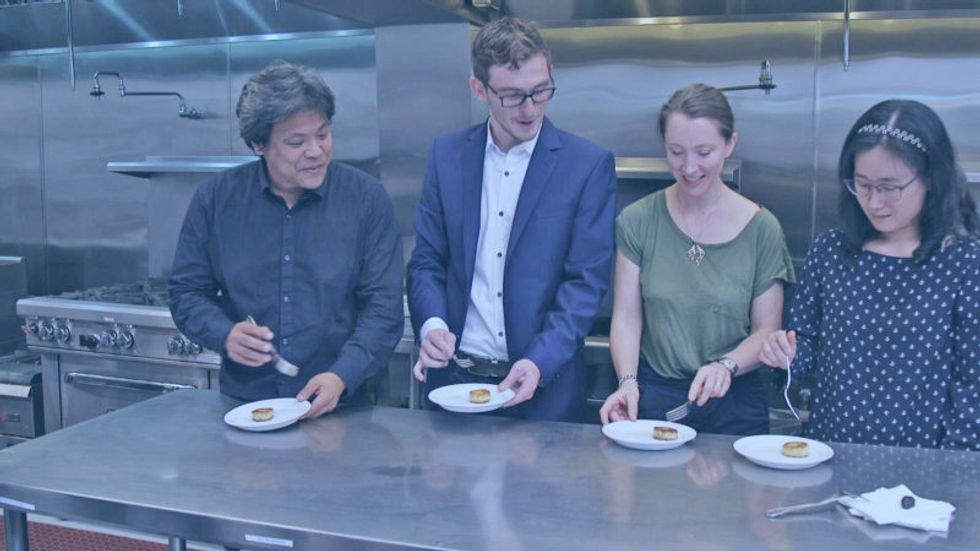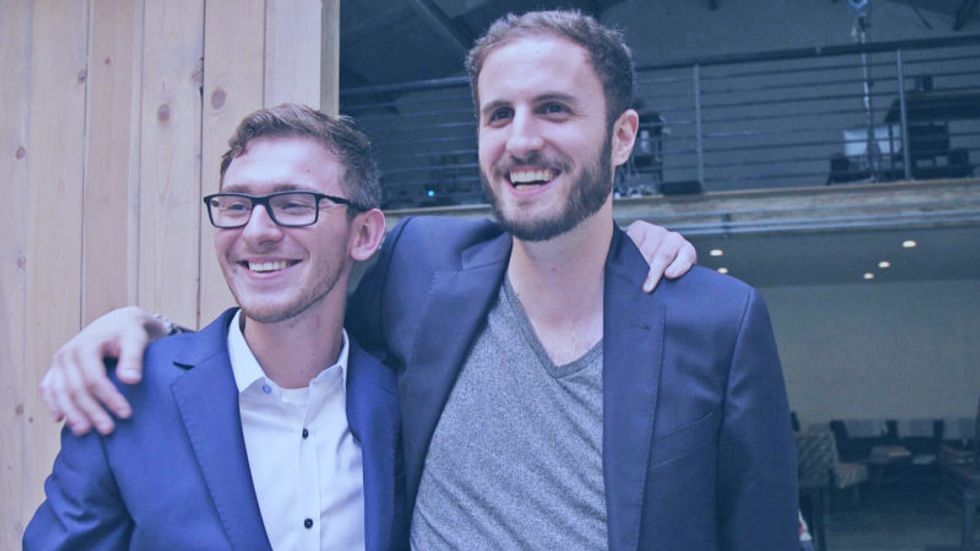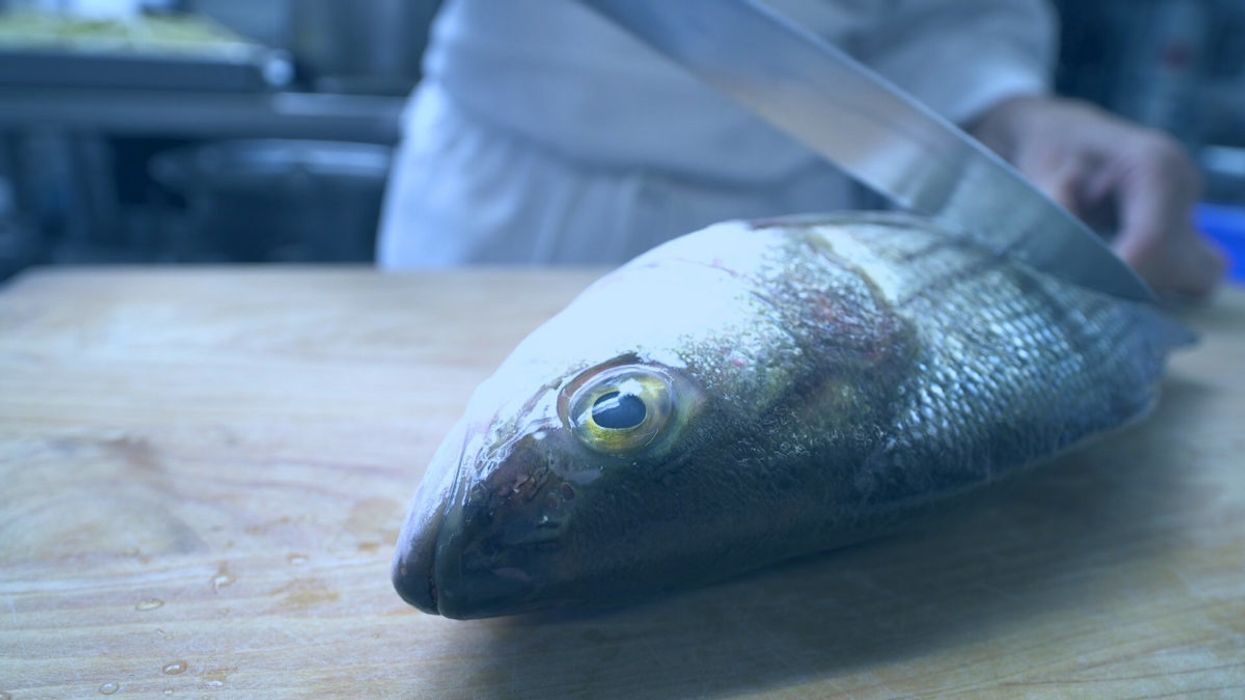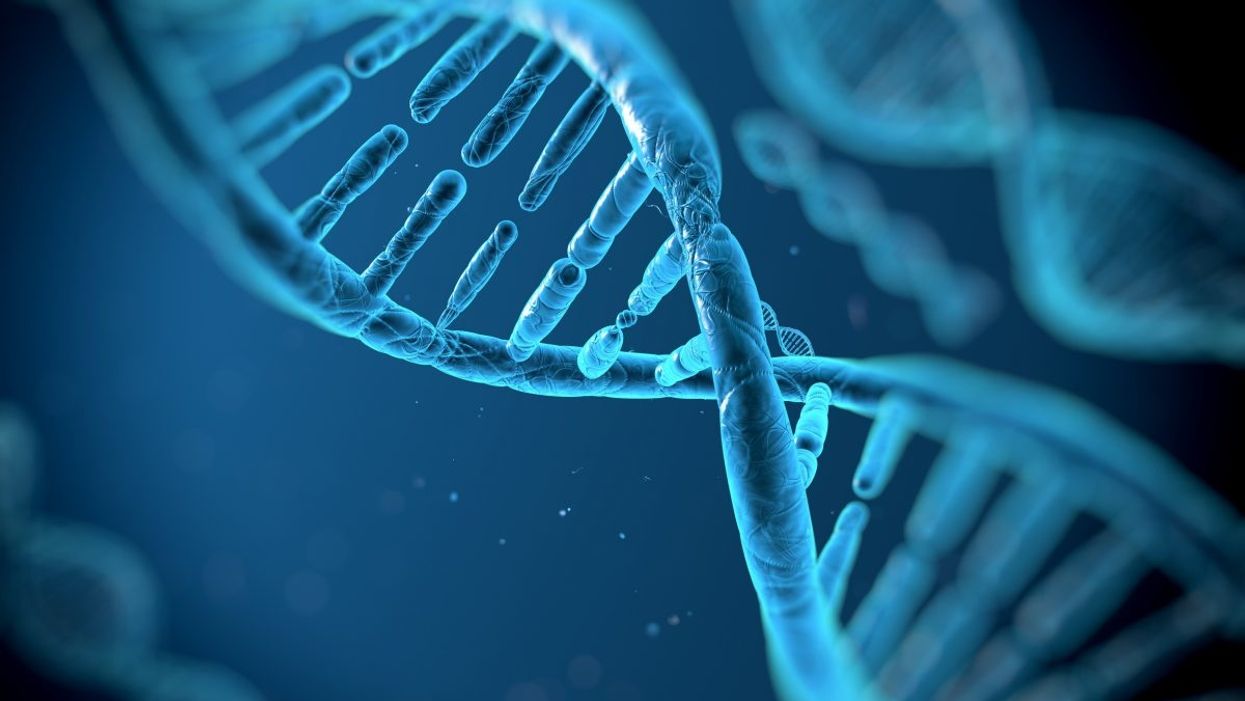When doctors couldn’t stop her daughter’s seizures, this mom earned a PhD and found a treatment herself.

Savannah Salazar (left) and her mother, Tracy Dixon-Salazaar, who earned a PhD in neurobiology in the quest for a treatment of her daughter's seizure disorder.
Twenty-eight years ago, Tracy Dixon-Salazaar woke to the sound of her daughter, two-year-old Savannah, in the midst of a medical emergency.
“I entered [Savannah’s room] to see her tiny little body jerking about violently in her bed,” Tracy said in an interview. “I thought she was choking.” When she and her husband frantically called 911, the paramedic told them it was likely that Savannah had had a seizure—a term neither Tracy nor her husband had ever heard before.
Over the next several years, Savannah’s seizures continued and worsened. By age five Savannah was having seizures dozens of times each day, and her parents noticed significant developmental delays. Savannah was unable to use the restroom and functioned more like a toddler than a five-year-old.
Doctors were mystified: Tracy and her husband had no family history of seizures, and there was no event—such as an injury or infection—that could have caused them. Doctors were also confused as to why Savannah’s seizures were happening so frequently despite trying different seizure medications.
Doctors eventually diagnosed Savannah with Lennox-Gaustaut Syndrome, or LGS, an epilepsy disorder with no cure and a poor prognosis. People with LGS are often resistant to several kinds of anti-seizure medications, and often suffer from developmental delays and behavioral problems. People with LGS also have a higher chance of injury as well as a higher chance of sudden unexpected death (SUDEP) due to the frequent seizures. In about 70 percent of cases, LGS has an identifiable cause such as a brain injury or genetic syndrome. In about 30 percent of cases, however, the cause is unknown.
Watching her daughter struggle through repeated seizures was devastating to Tracy and the rest of the family.
“This disease, it comes into your life. It’s uninvited. It’s unannounced and it takes over every aspect of your daily life,” said Tracy in an interview with Today.com. “Plus it’s attacking the thing that is most precious to you—your kid.”
Desperate to find some answers, Tracy began combing the medical literature for information about epilepsy and LGS. She enrolled in college courses to better understand the papers she was reading.
“Ironically, I thought I needed to go to college to take English classes to understand these papers—but soon learned it wasn’t English classes I needed, It was science,” Tracy said. When she took her first college science course, Tracy says, she “fell in love with the subject.”
Tracy was now a caregiver to Savannah, who continued to have hundreds of seizures a month, as well as a full-time student, studying late into the night and while her kids were at school, using classwork as “an outlet for the pain.”
“I couldn’t help my daughter,” Tracy said. “Studying was something I could do.”
Twelve years later, Tracy had earned a PhD in neurobiology.
After her post-doctoral training, Tracy started working at a lab that explored the genetics of epilepsy. Savannah’s doctors hadn’t found a genetic cause for her seizures, so Tracy decided to sequence her genome again to check for other abnormalities—and what she found was life-changing.
Tracy discovered that Savannah had a calcium channel mutation, meaning that too much calcium was passing through Savannah’s neural pathways, leading to seizures. The information made sense to Tracy: Anti-seizure medications often leech calcium from a person’s bones. When doctors had prescribed Savannah calcium supplements in the past to counteract these effects, her seizures had gotten worse every time she took the medication. Tracy took her discovery to Savannah’s doctor, who agreed to prescribe her a calcium blocker.
The change in Savannah was almost immediate.
Within two weeks, Savannah’s seizures had decreased by 95 percent. Once on a daily seven-drug regimen, she was soon weaned to just four, and then three. Amazingly, Tracy started to notice changes in Savannah’s personality and development, too.
“She just exploded in her personality and her talking and her walking and her potty training and oh my gosh she is just so sassy,” Tracy said in an interview.
Since starting the calcium blocker eleven years ago, Savannah has continued to make enormous strides. Though still unable to read or write, Savannah enjoys puzzles and social media. She’s “obsessed” with boys, says Tracy. And while Tracy suspects she’ll never be able to live independently, she and her daughter can now share more “normal” moments—something she never anticipated at the start of Savannah’s journey with LGS. While preparing for an event, Savannah helped Tracy get ready.
“We picked out a dress and it was the first time in our lives that we did something normal as a mother and a daughter,” she said. “It was pretty cool.”
Forget Farm-to-Table: Lab-to-Table Fresh Fish Is Making Waves
A conventionally sourced sea bass from a fishery.
Ever wonder why you've never heard of wild-caught organic fish? It's because there's no way to certify a food that has a mysterious history. Mike Selden, a 26-year-old biochemist with an animal lover's heart and an entrepreneur's mind, decided there must be better way to consume one of our planet's primary sources of animal protein. A way that would eliminate the need to kill billions of fish per year while also producing toxin-free, cheap, delicious fish meat for your dinner table. Enter Finless Foods, a young startup with a bold vision. Selden took time out of chauffeuring fish carcasses around San Francisco (no joke!) to share his journey with LeapsMag.
What is the biggest problem with the way fish is consumed today?
There are a lot of problems ranging from metals to animal welfare to human health. Technology is solving those problems at the same time. You've got extreme over fishing, which is collapsing ocean ecosystems and removing populations of fish that are traditionally used as food sources in developing nations.
In terms of animal welfare, fish are killed in massive numbers, billions a year. Even if people don't care too much about that, we want to give them another option.
In terms of health, which I think for most people is the most convincing argument, current fish have mercury and plastic in them. And if you're getting that fish from a farm, you will also have high levels of antibiotics and growth hormones if you're getting it from outside the U.S. What we're doing is producing fish that doesn't have any of those contaminants.
What gave you the idea to start a company around lab-grown fish?
I studied biochemistry and molecular biology at UMass Amherst, traditionally an agricultural school out in the woods of Massachusetts. I have always been an environmental activist and cared about animals. I thought, animal agriculture is so incredibly inefficient, what could be done to change it?
"The worst way you can possibly make a hamburger is with a cow."
Agriculture is a system of inputs and outputs, the inputs being feed and the outputs being meat – so why are we wasting all of this input on outputs we don't care about? Why are we creating these animals that waste all this energy through sitting around, moving around, having a heartbeat, blinking? All of this uses energy and that's valuable input.
The worst way you can possibly make a hamburger is with a cow. It's an awful transfer of energy: you have to feed it many times its own weight in food that could have fed other people or other things.
In February, I got funding from Indie Bio, a startup accelerator for synthetic biology, and moved out to San Francisco with my co-founder Brian Wyrwas. We started working in our lab in March. We're the newest company in the space.
Walk me through the process of creating edible fish in the lab. Do you have to catch a real live fish first and get their cells?
We have a deal with the Aquarium of the Bay, and whenever a fish dies, they call me, I get in a zip car, drive over, and bring the fish back to the lab, where Brian cultures it up into a cell culture. We do use real, high-quality fish stock. From there, we get the cells going in a bioreactor in a suspension culture, grow them into large quantities, and then bring them out to differentiate them into the cells people want to eat—the muscle and fat tissue. Then we formulate it and bring it to people's tables.
How long does the whole process take from the phone call about the fish dying to the food on the table?
There are two different processes: One is a research process, getting the initial cells and engineering them to be what we're looking for.
The other is a production process – we have a cell line ready and need to grow it out. That timing depends on how big of a facility we have. Since we're working with cell division: If you have 1 cell, in 24 hours, you'll have two cells. Let's say you have 1 ton of cells, in 24 hours you'll have two tons of cells.
"We want to give people the wholesome food they are used to in a healthier setting."
How are you looking to scale this process?
We're trying to find a middle ground between efficiency and local distribution. Organic farming is hilariously bad for the environment and horrifyingly inefficient, but on the other hand, industrial agriculture requires lots of transport, which is also bad for the environment. We're looking to create regionally distributed facilities which don't require a lot of transit, so people can have fresh fish even extremely far inland.
What kinds of fish are you "cooking"?
Our first product will be Bluefin tuna. It's a high-quality fish with high demand and it's also a conservation issue. We also currently have a culture going with Branzino, European sea bass, that we're really happy with.
There's a concept in science called a model organism – one that is extremely well studied and understood. Like the fruit fly, for example. For fish, it's the zebra fish, which is used for genetic research, but no one eats it. It's tiny, so we started by thinking: what fish do people eat that is also close evolutionarily to the zebra fish? We came up with carp, even though it's not too widely eaten.
But our process is very species agnostic. We've done work in trout, salmon, goldfish. Any fish with a dorsal fin works with our process. We tried a wolf eel but it didn't work. Eels are pretty far evolutionarily from fish, so we dropped that one.

From left to right, Ron Shigeta (IndieBio), Brian Wyrwas (Finless Foods), Amy Fleming (The Guardian), and Jihyun Kim (Finless Foods) tasting the first ever clean carp croquettes.
(Courtesy Mike Selden)
Why fish as opposed to, say, a cow?
Scientifically, there are a lot of advantages. Fish have a simpler structure than land animals. A fillet from a cow has complex marbling going on between the fat and muscle. When it's fish, like sashimi, it's in layers of muscle and fat. So it's simpler to build, plus fish are cold-blooded, so because they breathe underwater, our equipment needs less complexity. We don't need a CO2 line and we don't need to culture our cells at 37 degrees Celsius. We culture them at room temperature.
It's also easier to get to market since there's much higher value. Chicken in the last year was $3.84 per pound in America, whereas Bluefin tuna is between $100 and $1200 a pound. Because this is about dropping cost, we can get to market faster and give investors a better value proposition.
What's also cool is that something like Bluefin tuna is something many people haven't had the opportunity to eat. We can get these down in cost until there is price parity with any cheap conventional fish. We want to give people a choice between buying something like albacore tuna in a can –with mercury and plastic– or high-quality tuna without any contaminants for the same price.
Do you shape them like fish fillets to help the consumer overcome whatever discomfort they might feel about eating a bunch of lab-grown cells?
Yeah, people want to continue eating food they are eating, and that's fine. We want to give people a better option. We don't want to give them something weird and out there. We want to give them the wholesome food they are used to in a healthier setting that also solves some environmental issues.
How about the taste? Have you done any blind side-by-side tests with the real thing and your version?
Not blind taste tests. But we have been tasting it, and it is firmly fish. I even tried leaving it outside of the fridge – and man, that tasted like spoiled fish.
We want it to have the exact same properties as real fish. We don't want people to have to learn how to cook with it. We want them to just bring it into their homes and eat it exactly like they were doing before, but better.
What you're growing isn't the whole fish, right? It is not an actual organism?
Right, we're only growing muscle cells. It doesn't know where it is. There is no brain, nervous system, or pain receptors.
Are you the only people in this lab-grown food space working on fish?
We're the only ones doing fish so far. Other companies are doing chicken, duck, egg white, milk, gelatin, leather, and beef.
Are people generally weirded out by sci-fi lab food, or intrigued?
It's been very positive. When people sit down and talk to us, they realize it's not some crazed money grab or some weird Ted talk, it's real activists using real science trying to solve real problems. Sure, there will be some pushback from people who don't understand it, and that's fine.
When can I expect to see Finless Food at my local Whole Foods?
We plan on being in restaurants in two years, and grocery stores in four years.
What about people who aren't big fans of fish in the first place? Like those who don't eat sushi, because consuming something raw with an unknown history isn't very appetizing.
There are too many examples of food poisoning because fish are in a less clean environment than they should be, swimming around in their own fecal matter, and being doused in antibiotics so their diseases don't transmit. It's a bit of a mess. That's why as an industry, we're calling this clean meat. Fish is a healthy thing, or at least it should be, with Omega 3 and 6, and DHA. This is a way for people to continue getting those nutrients without any of the questions of where it came from. For people who are skeptical of fish, we invite you to dive in.

Brian Wyrwas, Co-Founder & CSO, and Mike Selden, Co-Founder & CEO
(Courtesy Mike Selden)
Kira Peikoff was the editor-in-chief of Leaps.org from 2017 to 2021. As a journalist, her work has appeared in The New York Times, Newsweek, Nautilus, Popular Mechanics, The New York Academy of Sciences, and other outlets. She is also the author of four suspense novels that explore controversial issues arising from scientific innovation: Living Proof, No Time to Die, Die Again Tomorrow, and Mother Knows Best. Peikoff holds a B.A. in Journalism from New York University and an M.S. in Bioethics from Columbia University. She lives in New Jersey with her husband and two young sons. Follow her on Twitter @KiraPeikoff.
Why the Panic Over "Designer Babies" Is the Wrong Worry
BIG QUESTION OF THE MONTH: Should we use CRISPR, the new technique that enables precise DNA editing, to change the genes of human embryos to eradicate disease--or even to enhance desirable traits? LeapsMag invited three leading experts to weigh in.
CRISPR is producing an important revolution in the biosciences, a revolution that will change our world in fundamental ways. Its implications need to be discussed and debated, and not just by scientists and ethicists. Unfortunately, so far we are debating the wrong issues.
Controversy has raged about editing human genes, particularly the DNA of embryos that could pass the changes down to their descendants. This technology, human germline editing, seems highly unlikely to be broadly available for at least the next few decades; if and when it is, it may well be unimportant.
Human germline editing is unlikely to happen soon because it has important safety risks but almost no significant benefits.
Human germline editing is unlikely to happen soon because it has important safety risks but almost no significant benefits. The risks – harm to babies – are compelling. We care a lot about babies. A technology that worked 95 percent of the time (and produced disabled or dying infants "only" five percent of the time) would be a disaster. Our concern for babies will lead, at the least, to rigorous legal requirements for preapproval safety testing. Many countries will just impose flat bans.
But these risks also have implications beyond safety regulation. For this technology to take off, physicians, assisted reproduction clinics, and geneticists will have to be willing to put their reputations – and their malpractice liability – on the line. And prospective mothers will have to be willing to take unknown risks with their children.
Sometimes, large and unknown risks are worth taking, but not here. For the next few decades, human germline editing offers almost no substantial benefits, for health or for enhancement.
Prospective parents already have a tried and true alternative to avoid having children with genetic diseases: preimplantation genetic diagnosis (PGD). In PGD, clinicians remove cells from three- to five-day-old embryos. Those cells are then tested to see which embryos would inherit the disease and which would not. This technology has been in use for over 27 years and is safe and effective. Rather than engaging in editing an embryo's disease-causing DNA, parents can just select embryos without those DNA variations. For so-called autosomal recessive diseases, three out of four embryos, on average, will be disease free; for autosomal dominant diseases, half will be.
Only a handful of prospective parents would need to use gene editing to avoid genetic disease.
Couples where each has the same recessive condition (cystic fibrosis) or where one of them has the terrible luck to have two copies of the DNA variant for a dominant disease (Huntington's disease). In those cases, the prospective parents would need to stay alive long enough to be able, and be sufficiently healthy to want, to have children. In a world of 7.3 billion humans, there will be some such cases, but they will probably be no more than a few thousand – or hundred.
People are also concerned about germline editing for genetic enhancement. But this is also unlikely anytime soon. We know basically nothing about genetic variations that enhance people beyond normal. For example, we know hundreds of genes that, when damaged, affect intelligence – but these all cause very low intelligence. We know of no variations that non-trivially increase it.
Over the next few decades, we might (or might not) learn about complex diseases where several genes are involved, making embryo selection less useful. And we might (or might not) learn about genetic enhancements involving DNA sequences not typically found in prospective parents and so not available to embryo selection. By that time, the safety issues could be resolved.
And, even then, how worried should we be – and about what? A bit, but not very and not about much.
"The human germline genome is not the holy essence of humanity."
The human germline genome is not the holy essence of humanity. For one thing, it doesn't really exist. There are 7.3 billion human germline genomes; each of us has a different one. And those genomes change every generation. I do not have exactly the same genetic variations my parents received from my grandparents; my children do not have exactly the ones I received from my parents. The DNA changed, through mutation, during each generation.
And our editing will usually be insignificant in the context of the whole human genome. For medical purposes, we will change some rare DNA variations that cause disease into the much more common DNA variations that do not cause disease. Rare, nasty variants will become rarer, but civilization changes these frequencies all the time. For instance, the use of insulin has increased the number of people with DNA variations that predispose people to type 1 ("juvenile") diabetes – because now those people live long enough to reproduce. Even agriculture changed our DNA, leading, for example, to more copies of starch-digesting genes. And, in any event, what is the meaningful difference between "fixing" a disease gene in an embryo or waiting to fix it with gene therapy in a born baby . . . other than avoiding the need to repeat the gene therapy in the next generation?
If genetic enhancement ever becomes possible in a non-trivial way, it would raise important questions, but questions about enhancement generally and not fundamentally about genetics. Enhancement through drugs, prosthetics, brain-computer interfaces, genes, or tools (like the laptop I wrote this on) all raise similar ethical issues. We can use the decades we will have to try to think more systematically about the ethical and policy issues for all enhancements. We should not panic about germline genetic enhancement.
One superficially appealing argument is that we are not wise enough to change our own genomes. This ignores the fact that we have been changing our genomes, inadvertently, since at least the dawn of civilization. We do not have to be wise enough to change our genome perfectly; we just need to be wise enough to change it better than the random and unforeseen ways we change it now. That should not be beyond our power.
Human germline editing will not be a concern for several decades and it may never be an important concern. What should we be paying attention to?
Non-human genome editing. Governments, researchers, and even do-it-yourself hobbyists can use CRISPR, especially when coupled with a technique called "gene drive," to change the genomes of whole species of living things – domestic or wild; animal, vegetable, or microbial – cheaply, easily, and before we even know it is happening. We care much less about mosquito babies than human ones and our legal structures are not built for wise and nuanced regulation of this kind of genome editing. Those issues demand our urgent attention – if we can tear ourselves away from dramatic but less important visions of "designer babies."
Editor's Note: Check out the viewpoints expressing condemnation and enthusiastic support.

